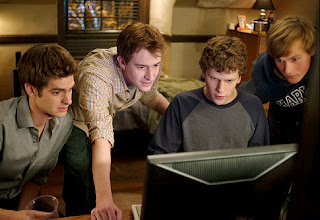

1. Inside Job: Charles Ferguson’s masterful look at the unchecked greed that caused our economy to almost collapse in 2008, and at the close ties between those charged with monitoring Wall Street excess and those getting rich from it. It unfolds like a great thriller, filling you with outrage while at the same time making a complex subject accessible.
2. Exit Through the Gift Shop: Count me among those who believe this Banksy-“directed” look at the world of street art and its cooptation by consumer culture isn’t really a straightforward documentary. But if the movie itself is a prank, it’s a deeply layered, clever one that makes you love it — and art itself — all the more.
3. A Film Unfinished: This disturbing, mournful meditation by Yael Hersonski on the meaning of 60 minutes of forgotten raw footage that the Nazis shot in the Warsaw Ghetto is an important addition to Holocaust studies. It shows the cavalier, inhuman way the Germans tried to exploit as Jewish-caused the horrors of ghetto life — starvation, corpses in the streets, improper sanitation — that their own genocidal policies caused.
4. Jean-Michel Basquiat: The Radiant Child: Director Tamra Davis had interviewed the doomed young artist in the 1980s, right as he was becoming an art star, and uses that footage as a starting point to build this perceptive study of his life. Among her important points is that he wasn’t a naf — he was well-informed on art and culture and smart about his intentions.
5. Joan Rivers: A Piece of Work: Directors Annie Sundberg and Ricki Stern treat Rivers with respect, not as the desperate, aging celebrity that pop culture likes to present her as. She rewards them by revealing the tough, sensitive, shrewd, outraged and outrageous comedian-philosopher that she has always been.
6. Casino Jack and the United States of Money: Alex Gibney intricately lays out the way Republican lobbyist Jack Abramoff, working with the Republican House Majority leader Tom DeLay and others (including former Ohio Rep. Bob Ney) put the interests of the country (and, in some cases, Abramoff’s own clients) second to their own financial interests. It’s a strong, penetrating indictment of Republican politics in the George W. Bush era.
7. Who Is Harry Nilsson (and Why Is Everybody Talkin’ About Him)?: In the year’s best music documentary, director John Scheinfeld reminds Boomers (and educates younger viewers) about how gifted a singer-songwriter the late Nilsson was. While he doesn’t shy away from depicting the artist’s self-destructive, substance-abusing side, he also shows that Nilsson never stopped trying to be a productive, caring human being.
8. The Tillman Story: With the cooperation of Pat Tillman’s family, director Amir Bar-Lev methodically unravels the government cover-up about how the football-player-turned Army Ranger was killed in Afghanistan, and the attempt to turn the atheist, intellectual athletic star into a clichéd stereotype of a God-fearing, unquestioning soldier. After the movie, I felt I knew him much better.
9. Gasland: Thanks to HBO for presenting this provocative, artfully made film by Josh Fox about the environmental dangers of a form of natural-gas drilling called “fracking” and the role Vice President Dick Cheney played in making it easier to do. It’s a useful, unexpected addition to the debate on energy policies.
10. The Art of the Steal: Don Argott’s look at the history of Philadelphia’s Barnes Collection of priceless Impressionist art portrays the imperious Dr. Albert Barnes as a rebel against Philadelphia blue-blood society who fought to keep his art out of their greedy hands. I don’t completely buy it — Barnes seems to have confused the collecting art with the making of it in terms of importance — but this is a lively, opinionated slice of American art-collecting and museum history.

























